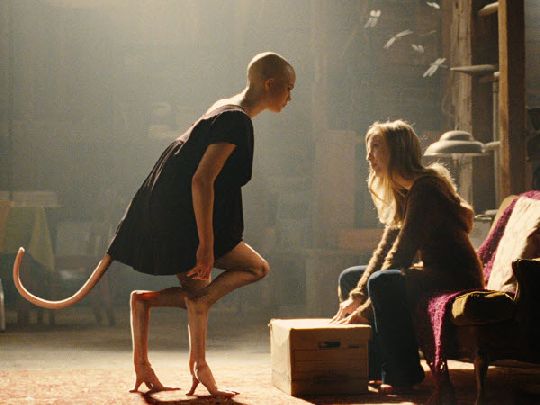Splice (2009) 
“On June 4th… Meet Dren.”

Director: Vincenzo Natali
Cast: Adrien Brody, Sarah Polley, Delphine Chaneac
Synopsis: Genetic engineers Clive Nicoli and Elsa Kast hope to achieve fame by successfully splicing together the DNA of different animals to create new hybrid animals for medical use.
She’s alive! Yes, indeedy — with Vincenzo Natali’s Splice, the hoary old Frankenstein legend is given a high-tech makeover, hauling its inert body into the 21st Century while thudding into every predictable plot-line you can think of on its journey. We get two Frankensteins for our money here, though: genetic engineers Clive Nicoli (Adrien Brody — The Pianist, Midnight in Paris) and Elsa Kast (Sarah Polley -Dawn of the Dead). Elsa’s one of those feisty, independently-minded women which, in movie-land, means that she’s a real pain in the backside who ignores other people’s opinions if they conflict with her own, and who, in real life, would be unable to maintain a relationship for more than three months with any man in possession of appendages that swing. That at least explains why she and the insipid Clive are a couple, because he spends most of the movie angrily explaining to Elsa why she shouldn’t have done what she did before timidly going along with what she did anyway.
The movie begins with a birth scene shot from the point-of-view of the creature being born. Why? Who knows. The birthday boy plays only a small part in the movie, and we’re never asked to identify or sympathise with him in any way. He’s the second spawn of the nature-tinkering experiments of Clive and Elsa (think Bride of Frankenstein), and they coo over him like the proud parents that they are, even though he looks like something from a 1950s monster movie. But it’s the couple’s third ‘child’ that this movie is about, a creature created when human DNA is added to the splicing ingredients. Quite what the other ingredients are, and in what measure they are present is never made clear, but judging by its appearance it’s safe to say there’s some scorpion in there, a bit of velociraptor, a couple of teaspoonfuls of gerbil, a pinch of kangaroo and a dash of moth. How, we have to ask ourselves, could anything possibly go wrong?
Well, go wrong they do, but it takes us quite a while to get there, and bizarrely the journey resembles nothing less than the typical domestic dramas faced by the parents of a wilful, headstrong daughter (and we all know where she got that from, even though Natali and his co-writers Antoinette Terry Bryant and Doug Taylor treat it like some major reveal when Clive finally twigs to the fact). The creature, who gradually evolves into French model Delphine Chaneac and is christened Dren, learns to communicate by spelling out words and, like teenagers around the world, announces that she’s bored; ‘mother’ and ‘daughter’ argue over the pet cat Dren befriends in the shed that becomes home after Colin and Elsa run out of places to hide her in the research facility, and they fight because Elsa won’t allow Dren to go out. Meanwhile, while Mum’s the bad guy, Dad’s the good guy who plays records and dances with his daughter.
The idea of a female Frankenstein and how the nurturing nature of a woman would impact on the relationship between her and her creation is an intriguing one that deserves a much better treatment than the one it receives from Splice. In fact, it’s difficult to imagine one aspect of the story that isn’t botched in some way, or which stretches incredulity to snapping point so that the audience is taken out of the movie as it ponders over yet another WTF moment. When Dren learns to communicate as a child by placing four blocks together to form the word Nerd, Elsa is understandably delighted, but does she then work at developing those communication skills? You bet your life she doesn’t. When the adolescent Dren develops a taste for raw meat after growing up on a high-glucose diet is Elsa concerned? You bet your life she isn’t — she just dismisses it as an accident. I could go on — the likelihood of being able to forsake your workload to secretly raise a new artificial life-form right under the noses of your employer without anyone suspecting, for example. Or how an experiment subject can change sex with nobody noticing — but the targets are too large and numerous for it to be much fun.
Splice is an example of a filmmaker who refuses to allow the realities of the situation they have created to intrude upon their story’s pre-determined path. If such realities should need addressing, then they do so only perfunctorily simply to get it out of the way. It’s a shame, because Splice does at least provide one interesting slant on an otherwise overly familiar story…
httpv://www.youtube.com/watch?v=CbBL3kzgmXs
